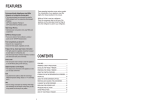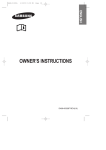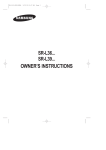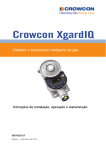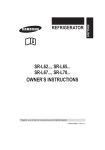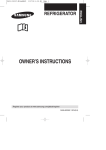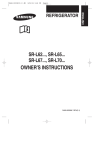Download Samsung Rl 39 Operating instructions
Transcript
ENGLISH OWNER’S INSTRUCTIONS Register your product at www.samsung.com/global/register DA68-01281L REV(0.3) Downloaded from Fridge-Manual.com Manuals FEATURES These operating instructions cover various models. The characteristics of your appliance may differ slightly from those described in this manual. Environment-friendly fridge/freezer using R600a refrigerant and cyclopentane blowing agent. • This products protects the environment by using the R600a refrigerant and the cyclopentane blowing agent. • Properties: ODP (Ozone Depletion Potential): 0 GWP (Global Warming Potential): Lowest R600a or R134a is used as a refrigerant. Check the compressor label on the rear of the appliance and the rating label inside the fridge to see which refrigerant is used for your refrigerator. High-energy efficiency • Optimized power consumption when using R600a and cyclopentane. SUPER fast freezing function • Food can be stored in fresh conditions by cooling it quickly via the “SUPER” freezing function. Fresh compartment, just above 0°C • Drawer for dry or wrapped food. • Drawer for fresh salades, vegetables and fruits. Fridge at the top, drawer-type freezer at the bottom • The highly ergonomic vegetable compartment is placed at waist height as it is frequently used. • The drawer-type freezer minimizes temperature variations and stores food cleanly and conveniently. CONTENTS Power on/off • The main power switch is handy to switch the appliance on and off without pulling out the main plug. FEATURES................................................................................. 1 WARNINGS / SAFETY PRECAUTIONS ................................. 2 INSTALLING THE FRIDGE / FREEZER................................... 4 PREPARING THE FRIDGE / FREEZER................................... 5 USING THE CONTROL FEATURES..........................................5 STORING FOOD IN THE REFRIGERATOR OR FREEZER..... 8 MAKING ICE ............................................................................ 10 USING THE WATER DISPENSER (OPTION)........................ 11 REMOVING AND CLEANING THE ACCESSORIES............. 13 CLEANING THE WATER DISPENSER................................... 14 REPLACING THE INTERIOR LIGHT.......................................15 PROBLEMS AND SOLUTIONS .............................................. 15 USAGE PRECAUTIONS.......................................................... 16 VIEW OF YOUR FRIDGE / FREEZER.....................................17 Digital temperature control display • The display shows all functions of the appliance, so that you can easily control them. ECO • Just press the ECO button to obtain the most energyefficient temperature settings: freezer at -17°C and fridge at 6°C. VAC • Save on energy consumption by switching off the fridge and maintaining only the freezer running when you take a long vacation or are away for any reason. 1 Downloaded from Fridge-Manual.com Manuals WARNINGS / SAFETY PRECAUTIONS To avoid any risk of personal injury, material damage or incorrect use of the appliance, be sure to observe the following safety precautions. (After reading these owner’s instructions, please keep them in a safe place for reference). Remember to hand them over to any subsequent owner. Indicates that a danger of death or serious injury exists. Indicates that a risk of personal injury or material damage exists. Warning Caution Do not disassemble, repair or alter the appliance. • It may cause fire or abnormal operations, which may lead to injury. Warning Do not plug several appliances into the same socket. • This could cause overheating and the risk of fire. Pull the power plug out of the socket before replacing the interior light in the refrigerator. • Otherwise, there is a risk of electric shock. Keep the power plug away from the rear of the fridge/freezer. • A damaged power plug may cause fire due to overheating. Be sure to ground the appliance. • Otherwise, it may cause material damage and electric shock. Do not directly spray water inside or outside the fridge/freezer. • There is a risk of fire or electric shock. If you wish to dispose of the refrigerator / freezer, throw it away after removing the door or its seals. • In this way, it is not possible for a child to remain trapped inside it. Do not spray inflammable gas near the fridge/freezer. • There is a risk of explosion or fire. Do not bend the power cord excessively or place heavy articles on it. This constitutes a fire hazard. If the power cord is This appliance contains a small amount of isobutane refrigerant (R600a), a natural gas with high environmental compatibility, but it is also combustible. When transporting and installing the appliance, care should be taken to ensure that no parts of the refrigerating circuit are damaged. damaged, have it replaced immediately by the manufacturer, its service agent or a similarly qualified person. Do not insert the power plug with wet hands. • You may receive an electric shock. Refrigerant squirting out of the pipes could ignite or cause an eye injury. If a leak is detected, avoid any naked flames or potential sources of ignition and air the room in which the appliance is standing for several minutes. • In order to avoid the creation of a flammable gasDo not install the refrigerator / freezer in a damp air mixture if a leak in the refrigerating circuit occurs, place, where it may come into contact with water. the size of the room in which the appliance may be • Incorrect insulation of the electrical parts may sited depends on the amount of refrigerant used. cause an electric shock or fire. The room must be 1m3 in size for every 8 g of R600a refrigerant inside the appliance. The amount Do not store volatile and inflammable of refrigerant in your particular appliance is shown substances in the refrigerator. on the identification plate inside the appliance. • The storage of benzene, thinner, alcohol, ether, LP • Never start up an appliance showing any signs of gas or other such substances may cause an damage. If in doubt, consult your dealer. explosion. Do not put a container filled with liquid on top of the appliance. • If the water spills on to any electrical parts, it may lead to fire or electric shock. 2 Downloaded from Fridge-Manual.com Manuals Do not touch any containers and food in the freezer with wet hands. • It may cause frostbite. Warning • Keep ventilation openings in the appliance enclosure or mounting structure clear of obstruction. • Do not use mechanical devices or any other means to accelerate the defrosting process, other than those recommended by the manufacturer. • Do not damage the refrigerant circuit. • Do not use electrical appliances inside the fridge/freezer, unless they are of a type recommended by the manufacturer. Remove any foreign matter from the power plug pins. • Otherwise, there is a risk of fire. Do not insert your hand into the bottom area of the appliance. • Any sharp edges may cause personal injury. After unplugging the appliance, wait for at least five minutes before plugging it in again to the wall socket. • Abnormal operation of the freezer may cause material damage. Caution If the appliance is not to be used for a long period of time, pull out the power plug. • Any deterioration in the insulation may cause fire. Do not store too much food in the appliance. • When you open the door, an item may fall out and cause personal injury or material damage. Do not let children touch or play with the control panel on the front of the appliance. • Do not allow children to play with this appliance. • Do not stand or lean on the base panel, pull-out parts, doors and so on. • Repairs and maintenance of the appliance should only be performed by a qualified technician. Incorrect repairs by an unqualified person are a potential source of danger that may have critical consequences for the user of the appliance. • Never put ice cubes or ice lollies straight from the freezer into your mouth. (The low temperature may cause “freezer burns”.) Do not put bottles or any kinds of glass in the freezer. • The container may break and cause personal injury. If the wall socket is loose, do not insert the power plug. • If may cause electric shock or fire. Do not disconnect the power cord by pulling on it. • You may disconnect a wire and cause a short circuit. Do not store articles on top of the appliance. • When you open or close the door, the articles may fall and cause personal injury or material damage. Caution Do not store pharmaceutical products, scientific materials or other temperature-sensitive products in the refrigerator. • Products that require strict temperature controls must not be stored in the refrigerator. The refrigerant used in fridge/freezers and the gases in the insulation material require special disposal procedures. Ensure that none of the pipes on the back of the appliance are damaged prior to disposal. Do not let a child hang from the door. 3 Downloaded from Fridge-Manual.com Manuals INSTALLING THE FRIDGE/FREEZER Allow an adequate space and install the fridge/freezer on a firm, level floor. • If the appliance is not level, there may be unusual noises and poor cooling. • Wait for at least one hour before plugging the appliance in. Clean the fridge/freezer. • Wipe and clean the appliance inside and outside with a damp cloth. Plug the fridge/freezer into a wall socket used exclusively by this appliance. • This appliance must be properly grounded. Place the food in the fridge/freezer. • It is recommended that you wait for the appliance to cool for 2-3 hours before storing food in it. Warning Use of an grounded socket exclusively for the appliance: • If you are using a socket with an earthing terminal, you do not require a separate earthing connection. Use of a non-grounded socket: • Connect the “earthing wire” to the copper plate and bury it at a depth of at least 25 cm in the ground. 25cm LEVELLING If the front of the appliance is slightly higher than the rear, the door can be open and closed more easily. The appliance tilts down to the left. Turn the left adjusting leg in the direction of the arrow with a flat head screwdriver until the appliance is level. The appliance tilts down to the right. Turn the right adjusting leg in the direction of the arrow with a flat head screwdriver until the appliance is level. 4 Downloaded from Fridge-Manual.com Manuals PREPARING THE FRIDGE/FREEZER To prepare your appliance for use and check that it is running correctly, take the following steps. Install all shelves and compartments removed during transport in the correct positions. Clean the fridge/freezer and accessories to remove any dust that accumulated during packing and shipping. The interior light of the appliance will light up when the door is open. Set the temperature control to the coldest temperature and let the refrigerator operate for one hour. The freezer should get slightly chilled and the motor should run smoothly with a soft hum and no noise. Your fridge/freezer is operated by a compressor which switches “on and off” to maintain the internal temperature. When the compressor is new, it requires running in for a period of up to five months. During this period, it may be slightly noisy. This is quite normal and does not represent a fault. Store food once the temperature in the refrigerator is sufficiently low. It takes a few hours after starting the refrigerator to reach the proper temperature. If the appliance does not operate correctly, check the electricity supply. If the problem persists, contact your dealer. USING THE CONTROL FEATURES A. Basic Model On/Off Low Mid High Cooling Power ➀ On/Off Button • Main power on/off switch. • Switches the appliance on and off. Cooling Power button • Press the Cooling Power button to control the refrigerator temperature. • Initially, the mid-point temperature setting is selected. • There are five temperature settings, represented by five indicator lights (➀). When all lights are on, the temperature is at its coolest. • Press the Cooling Power button one or more times until the required temperature is set. • The freezer temperature will be adjusted automatically according to the refrigerator temperature. 5 Downloaded from Fridge-Manual.com Manuals B. Model with Digital Display Super ➁ ➀ ➂ ➄ ➃ ➅ POWER Button • Main power on/off switch. • Switches the appliance completely on or off. SUPER Button • Switches the fast freeze function on or off. • Use when you wish to freeze foods quickly. • The SUPER indicator ➀ remains on while the fast freeze function is running. • While this function is selected, the refrigerating device remains switched on continuously and produces a very low temperature inside the freezer. • The fast freeze function switches off automatically. When the fast freeze process is completed, the SUPER indicator ➀ switches off and the freezer switches back to the previous setting temperature. FRE.TEMP Button • In the normal model, the temperature displayed ➃ is the setting temperature of the freezer. • To change the freezer temperature: – Press the FRE.TEMP button. The current setting temperature is displayed (➃) preceded by “F” (➁). – Press the FRE.TEMP button one or more times or hold it down until the required temperature is displayed (➃). • The temperature changes in sequence. After -25°C, the display returns to -17°C again. • Freezer temperature range: -17°C to -25°C. Note Once the power is re-instated, the temperature display ➃ displays “– –”. In this case, the display “– –” is disappeared by pressing FRE. TEMP button or REF. TEMP button. 6 Downloaded from Fridge-Manual.com Manuals REF.TEMP Button • To change the refrigerator temperature: – Press the REF.TEMP button. The current setting temperature is displayed (➃) preceded by “R” (➁). – Press the REF.TEMP button one or more times or hold it down until the required temperature is displayed (➃). – When you complete the setting of refrigerator temperature, the refrigerator temperature display (➃) flashes 5 times and returns to the setting temperature of the freezer. • The temperature changes in sequence. After +6°C, the display returns to +1°C. • Refrigerator temperature range: +1°C to +6°C. Note The temperature display (➃) flashes “– –” if there has been a power failure. Check that the food stored in the appliance has not gone bad. ECO Button • To set the most energy-efficient temperature automatically for the refrigerator and freezer, simply press the ECO button. Freezer temperature: -17°C. Refrigerator temperature: 6°C. • The ECO indicator ➄ remains on while the ECO function is operating. • If you press the FRE.TEMP or REF.TEMP button, the ECO function is cancelled and the appliance is set to the new temperature selected. VAC Button • If you are going on a long vacation or business trip or you do not need to use the refrigerator, press the VAC button. • The refrigerator is switched off but the freezer remains on. • The VAC indicator (➅) remains on while the VAC function is operating. You must empty the refrigerator before pressing the VAC button. Caution Note If the SUPER, ECO or VAC mode is already selected and you press one of the other buttons, the current mode is cancelled and the mode corresponding to the button pressed is selected. It is possible, if the ECO mode is already selected and you press SUPER mode, the temperature of refrigerator and freezer is controlled independenty. (refrigerator : ECO mode, freezer : SUPER mode) 7 Downloaded from Fridge-Manual.com Manuals STORING FOOD IN THE REFRIGERATOR OR FREEZER When storing food in the appliance, follow the recommendations below. • Allow warm food and beverages to cool down before storing them in the appliance. • Ensure that food is well-wrapped or covered before it is stored. This will prevent food from dehydrating, deteriorating in colour or losing flavor and will help maintain freshness. It will also prevent cross-flavouring. • Never let any oil or grease come into contact with the plastic fittings or door seals, as these materials easily become porous. • Never store any explosive substances inside the appliance. High-proof alcohol should only be stored upright in tightly sealed containers. A. Refrigerator Transparent, safety glass shelf (optional) • Place food in storage containers and lay the items out at suitable intervals. • The storage shelf is of an unbreakable, transparent material, so that you can use it safely. Fresh salad drawers • Vegetable and fruit can be stored in this compartment. • It is possible, if you need more space to store vegetable and fruits, to remove drawers. • A declared storage volume of fresh food storage compartment is calculated with fresh salad drawers removed. Dairy and multi-purpose guard • Store fatty foods, like butter and cheese. • Store small, packed foods, like milk, yogurt and beverages. Bottle guard • Store small bottles and cartons (1 litre) of beer, milk, juice in the upper part and large bottles and cartons (1.5 litres) in the lower part. 8 Downloaded from Fridge-Manual.com Manuals B. Freezer Upper freezer drawer • Store packed frozen foods, like ice cream and bacon. Middle/lower freezer drawer • Store fresh meat and fish or dried foods, which are divided into suitably sized portions. Note For more space, you can store food with drawers and ice maker removed. A declared storage volume of frozen food storage compartment is calculated with ice cube, ice tray, upper and middle freezer drawers removed. Wrapping food Note Pack the food in suitably sized portions for your household. Vegetable and fruit portions should be no heavier than 1 kg, while meat portions can be up to 2.5 kg. Smaller portions freeze through more quickly and the quality is thereby maintained better when defrosting and preparing the food. It is important to seal food in airtight bags or containers before freezing to prevent it from losing favor or dehydrating. Wrap the food, press out any air and seal it airtight. Suitable wrapping materials: Plastic bags, cling-film, aluminium foil and freezer containers. These items are available from any dealer. Unsuitable wrapping materials: Wrapping paper, greaseproof paper, cellophane, bin bags or used carrier bags. Suitable sealing materials: Rubber bands, plastic clips, string, freezer tape or similar. Plastic film and bags may be heat-sealed using a special sealing iron or press. Before placing a package in the freezer, it should be clearly labelled with the contents and date of freezing. 9 Downloaded from Fridge-Manual.com Manuals MAKING ICE A. Twist type Pull out the ice cube maker. Fill trays in up to the water level mark (arrow). Put the ice cube maker back in position. Close the freezer door. Once the water has become frozen, turn the knobs on the ice cube trays to empty ice cubes into the storage bin. B. Normal type Pour water into the ice cube maker. • Fill the maker up to about 80% with water. Place the ice cube maker in the upper freezer drawer. To take out the ice cubes: • Twist the ice cube maker slightly. Danger of explosion Warning • The coldest parts of the refrigerator are the rear panel and the lowest shelf. This is the best place to store delicate foodstuffs. • Glass bottles containing liquids that can freeze should never be stored in the freezer as the glass will explode when the contents freeze. Note Making ice quickly To make a large quantity of ice quickly, press the “SUPER” button to select the fast freeze function. 10 Downloaded from Fridge-Manual.com Manuals USING THE WATER DISPENSER (OPTION) With the water dispenser, you can obtain chilled water easily without opening the refrigerator door. In addition, you can save electricity by more than 30% reducing the number of times the door is open. Overview Push lever Water tank cap Water tank Water supply device WHEN THE WATER DISPENSER IS NOT USED,THE FOLLOWING WAYS ARE RECOMMENDED Fix the water supply device tightly into the fixing hole. • The door will not be closed automatically when the water supply device is pulled out for a long time because of cold leaking. Place a separate spare beverage bottle in the location of the exclusive water tank. • Two 1.5 litre bottles can be used. FILLING THE WATER TANK Open the round cap and fill the water tank up with drinking water. • Fill the tank up to the full level (just over 4.2 litres). Close the round cap by pushing down on it until it clicks into proper place. Place a cup on the tray dispenser, then press the “PUSH” lever. 11 Downloaded from Fridge-Manual.com Manuals INSTALLING A REGULAR BOTTLE Press the fixing lever, lift the exclusive water tank upwards, then remove it. Remove the water supply device from the exclusive water tank, then set the inner groove of the water supply device in a regular mineral water bottle and fix it in position by turning it. Turn the water supply device over, then fix it in position in the fixing hole. Note • Gurgling sounds may be heard when air enters the water tank from regular mineral water or beverage bottles. • Some regular mineral water or beverage bottles may not fit the water supply device, depending on their size. • If water does not come out satisfactorily when you press the “push” button, press it again. • Do not use carbonated drinks, such as cola, cider or sodas. When you press the button, the beverage may spurt out due to the pressure of carbonic gas accumulated in the upper part of beverage bottle. • For better hygiene, beverages with a high sugar content (juice, soft drinks) are not recommended. • Use bottled mineral water or boiled tap water that does not contain any particles. 12 Downloaded from Fridge-Manual.com Manuals REMOVING AND CLEANING THE ACCESSORIES Before cleaning the appliance, you must always switch it off and unplug it from the wall socket. Do not use a steam cleaner. The hot steam could damage the surface of the appliance or the electrical components, causing a risk of electric shock. Ice cube maker (optional) • Hold the knob of ice cube maker, then pull the ice cube maker forward. • Remove the ice cube maker and rinse it in water. Ice tray (optional) • Using the handle, pull the ice tray out as far as it will go, then remove it by lifting it up slightly and pulling it towards you. Fresh salad drawers • Pull the salad drawers out as far as it will go, then remove it by lifting it slightly and pulling it towards you. • Wipe it with a damp cloth. Bottle guard • Hold the bottle guard in both hands, then remove it by lifting it slightly and pulling it towards you. • Wash it in water. Freezer drawer • Holding the freezer drawer in both hands, pull it out as far as it will go, then remove it by lifting it up slightly and pulling it towards you. • Wipe it with a damp cloth. Transparent, safety glass shelf (optional) • Remove the shelf, then clean it using water and detergent. • When replacing the shelves, do not mix up the top, middle and bottom shelves. Note When you remove the tempered glass shelves, load a glass and a trim simultaneously to prevent from dropping the glass. Rubber seals • Clean the rubber seals with a damp cloth and detergent. Use a wooden skewer wrapped in a small cloth to clean in the grooves. 13 Downloaded from Fridge-Manual.com Manuals CLEANING THE WATER DISPENSER Dispenser Tray Using the dispenser tray handle, remove the tray. Empty the water in the dispenser tray, then clean it using warm water and detergent. Dispenser tray Connection path Wipe out the connection path and surrounding area with a clean damp cloth. Water Tank / Supply Device Pull upward and disassemble the hooks on both sides of the large-sized cap. Loosen the water supply device by turning it in the direction of the arrow and removing it. Wipe the large-sized cap and the exclusive water tank with warm water and detergent. • Hold the cap and pull it upwards to remove it. Clean the cap and filtering bottle attached to the cap with a soft brush. After cleaning the water supply device with a soft brush, press the water supply device operation lever, then wash it in running water. • Clean the water tank frequently if it used to dispense tea or other such beverages. Only use filtered tea. For better hygiene, beverages with a high sugar content (juice, soft drinks) are not Caution recommended. • Deposits can be cleaned by wiping the tank with a cloth dampened in vinegar or salt water. • Check that the rubber seal on the water supply device has not slipped off or is not damaged by a sharp-edged object. Otherwise, it may leak. 14 Downloaded from Fridge-Manual.com Manuals REPLACING THE INTERIOR LIGHT Always unplug the appliance when replacing the refrigerator light. Otherwise, there is the danger of electric shock. Unscrew the cover with + head screwdriver. - Fluorescent light • Remove the interior light by pulling it downward, then replace it with a new one. - Incandescent light • Turn the interior light to pull it out and replace it with a new one. Screw the cover with + head screwdriver. PROBLEMS AND SOLUTIONS The appliance is not operating at all or the temperature is too high • Check that the power plug is correctly connected. • Is the temperature control on the front panel correctly set? • Does sun shine on the appliance or are there heat sources nearby? • Is the back of the appliance too near to the wall? The food in the refrigerator is frozen • Is the temperature control on the front panel set to the coldest temperature? • Is the surrounding temperature too low? • Did you put food with a high water content in the refrigerator? There are unusual noises • Check that the appliance is installed on a stable, level floor. • Is the back of the appliance too near to the wall? • Have any foreign objects fallen behind or under the appliance? • Is the noise coming from the compressor in the appliance? • A ticking sound may be heard inside the appliance; this is normal. This sound occurs when the various accessories contract or expand. The front corners and sides of the appliance are warm and condensation starts to form • Heat-proof pipes are installed in the front corners of the appliance to prevent condensation from forming. When the surrounding temperature rises, this may not always be effective. However, this is not abnormal. • In very humid weather, condensation may form on the outer surface of the appliance when the moisture in the air comes into contact with the cool surface of the appliance. 15 Downloaded from Fridge-Manual.com Manuals You can hear a liquid babbling in the appliance • This is the refrigerant, which cools the inside of the appliance. There is a bad smell inside the appliance • You did not seal the food. • Store foods covered and clean the cold inlet. There is a layer of frost on the appliance’s walls • Is the air outlet on the appliance plugged in? • Space the food out as much as possible to improve ventilation. • Is the door fully closed? Condensation forms on the inside wall of the appliance and around vegetables • Food with a high water content is stored uncovered with a high humidity level or the door has been left open for a long time. • Store the food with a cover or in sealed containers. USAGE PRECAUTIONS Store food with a high water content at the front of a refrigerator shelf. Store hot food in the appliance after it has cooled. • If you store cold food, you save on electricity and improve refrigeration. Tips Power Saving Tips • Install the appliance in a cool, dry room with adequate ventilation. Ensure that it is not exposed to direct sunlight and never put it near a direct source of heat (radiator, for example). • Never block any vents or grilles on the appliance. • Allow warm food to cool down before placing it in the appliance. • Put frozen food in the refrigerator to thaw. You can then use the low temperatures of the frozen products to cool food in the refrigerator. • Do not keep the door of the appliance open for too long when putting food in or taking food out. The shorter the time for which the door is open, the less ice will form in the freezer. 16 Downloaded from Fridge-Manual.com Manuals VIEW OF YOUR FRIDGE / FREEZER REFRIGERATOR LIGHT (fluorescent or incandescent, depending on the model) REFRIGERATOR REFRIGERATOR SHELVES (tempered glass, crystal or wire, depending on the model) MULTI-PURPOSE GUARD FRESH SALAD DRAWER BOTTLE GUARD TWIST ICE MAKER AND ICE STORAGE BIN (OPTION) FREEZER FREEZER DRAWER 17 Downloaded from Fridge-Manual.com Manuals WATER DISPENSER (OPTION) Ambient Room Temperature Limits This fridge/freezer is designed to operate in ambient temperatures specified by its temperature class marked on the rating plate. Temperature Class Extended Temperate Ambient Temperature Symbol Maximum Minimum SN 32°C (90°F) 10°C (50°F) Temperate N 32°C (90°F) 16°C (61°F) Subtropical ST 38°C (100°F) 18°C (64°F) T 43°C (109°F) 18°C (64°F) Tropical NOTE: Internal temperatures may be affected by such factors as the location of the fridge/freezer, ambient temperature and the frequency with which you open the door. Adjust the temperature as required to compensate for these factors. Correct Disposal of This Product (Waste Electrical & Electronic Equipment) English (Applicable in the European Union and other European countries with separate collection systems) This marking shown on the product or its literature, indicates that it should not be disposed with other household wastes at the end of its working life. To prevent possible harm to the environment or human health from uncontrolled waste disposal, please separate this from other types of wastes and recycle it responsibly to promote the sustainable reuse of material resources. Household users should contact either the retailer where they purchased this product, or their local government office, for details of where and how they can take this item for environmentally safe recycling. Business users should contact their supplier and check the terms and conditions of the purchase contract. This product should not be mixed with other commercial wastes for disposal. If you have any questions or comments relating to Samsung products, please contact the SAMSUNG customer care center. Samsung Electronics America, Inc. 1-800-SAMSUNG (7267864) www.samsung.com Downloaded from Fridge-Manual.com Manuals



















